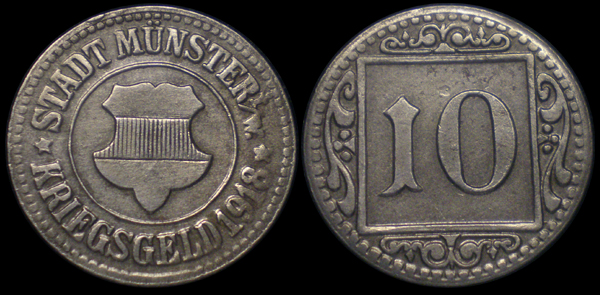
STADT MÜNSTER (GERMAN) 10 PFENNIG 1918
L- 339.5 City of Münster (Westphalia) Iron 10 Pfennig Coin Depicting City Coat of Arms.
This iron 10 pfennig coin was issued by the City of Münster and depicts the city coat of arms. On the reverse it says Kriegsgeld which literally translates as 'War Money'. Coins like this one were common and meant to be used as small change.
Münster is a German city situated on the river Aa roughly 15 km south of its confluence with the Ems river. The city is located in the northern part of the state of North Rhine-Westphalia. The city was founded by the Frisian missionary Liudger who was sent to the area by Charlemagne in 793 to convert the Saxons who had been a problem in the area for some time. He built a church and monetary on the banks of the river and It was from the 'monasterium' that the new settlement would derive its name.
In 805 Liudger was appointed as the first Bishop of Münster during a visit to Rome. Soon after came a school, a marketplace, and a library. All these combined with a favorable location by road and river allowed Münster to become one of the most important centers for religion, education, and trade in the area. It also became an important ecclesiastical administration center and a leading member of the Hanseatic League.
It was in Münster that John of Leiden declared himself king and founded the Anabaptist theocracy in 1534. Prince-Bishop Franz von Waldeck suppressed this movement and the bodies of the publicly executed Anabaptists were displayed in cages as a warning to others who may think of taking such action in the future. These cages still hang in the tower of St. Lambert’s Church today.
Münster is best know for having been the site of the 'Peace of Westphalia' which put and end to the 'Thirty Years War' and from which the Netherlands and Switzerland gained their sovereignty.
In the late 18th century Münsters first university was established, the city would continue to grow and become a mecca for education. It is now home to eight universities. In 1816 Münster was named the capitol of the Province of Westphalia in the Kingdom of Prussia and the city became the seat of a multitude of different civil administrations.
Because Münster was heavily garrisoned it was bombed heavily bombed during World war II. These bombings destroyed most of the historic areas of the city and roughly half of the total city. Post World War II the old city was rebuilt as it was pre-war.
In 1915 the population of Münster was estimated to be over 100,000 and it was officially designated as a Großstadt (major City). Today the population is almost three times this number.
Münster remains a city with not only a healthy service business sector but it remains a hub for education, religion, as well as civil and judicial administration. Because of its history, art, and architecture it is also a popular holiday tour destination.
